Sem 09
Urban Architecture
Prasad Shetty
At the core of this project is an orientation towards not solving urban problems - as these are too complex to be solved through architectural projects; but rather to use urban forces to create moments of joy and new possibilities for life.
Don’t tell anyone
I heard something the other day
From my maid
Actually I overheard a conversation between her and my mother
She had just come from the neighbouring building
One of her other jobs
She has several in this neighbourhood
She had heard from her friend who works in that building
Her friend heard from one of the watchmen nearby
Or the istriwala? I’m not sure
I often see them hanging out near the building gate
I think they’ve come from the same village
Or belong to the same caste
Watchman apparently heard from my building secretary uncle
Who is always sitting outside on that bench beside the pan shop
On the nukkad with other old men
Secretary uncle will never admit but he hears almost everything from the sandwich guy across the road from the pan shop
And the chai wala in the stall beside him
They heard from one of the vegetable market vendors
His wife is good friends with few of the fisher women in the market
They might have also heard from the auto drivers
Specifically the auto driver repair guy,
Who’s always sitting at the corner of the road beside the shoe repair shop with his tools
He heard from the woman who sells coconuts
Its her family busines
She and her sons always set up shop outside the kirana shops
They have some agreement of claiming the footpath space
She heard from one of the delivery guys from the kirana shop
Who also sometimes does deliveries for the medical store across the road
He lives in the same nearby settlement as my maid
I don’t know who started it.
Radhika Malekar
I heard something the other day
From my maid
Actually I overheard a conversation between her and my mother
She had just come from the neighbouring building
One of her other jobs
She has several in this neighbourhood
She had heard from her friend who works in that building
Her friend heard from one of the watchmen nearby
Or the istriwala? I’m not sure
I often see them hanging out near the building gate
I think they’ve come from the same village
Or belong to the same caste
Watchman apparently heard from my building secretary uncle
Who is always sitting outside on that bench beside the pan shop
On the nukkad with other old men
Secretary uncle will never admit but he hears almost everything from the sandwich guy across the road from the pan shop
And the chai wala in the stall beside him
They heard from one of the vegetable market vendors
His wife is good friends with few of the fisher women in the market
They might have also heard from the auto drivers
Specifically the auto driver repair guy,
Who’s always sitting at the corner of the road beside the shoe repair shop with his tools
He heard from the woman who sells coconuts
Its her family busines
She and her sons always set up shop outside the kirana shops
They have some agreement of claiming the footpath space
She heard from one of the delivery guys from the kirana shop
Who also sometimes does deliveries for the medical store across the road
He lives in the same nearby settlement as my maid
I don’t know who started it.
Radhika Malekar
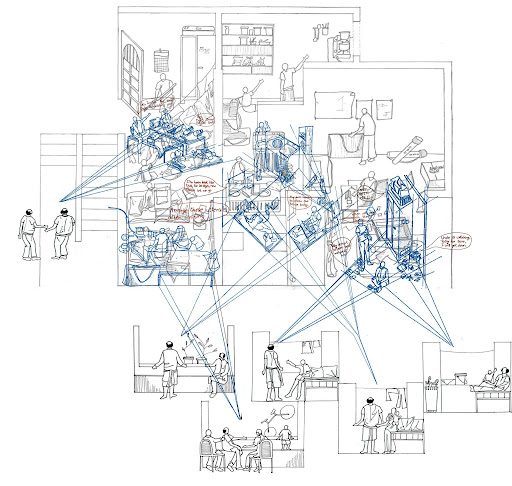

The site establishes a rhythm for the routine, where my evening activities, after returning home from college, are shaped by observing activities in my uncle's balcony, and vice versa.
On the site, conditions of objects play an important force need to be set, which forms the imagination for creating new narratives.
My response is to form the narratives for the uncle. The narrative through the evening shadows by using the floor as a screen for shadows to play.
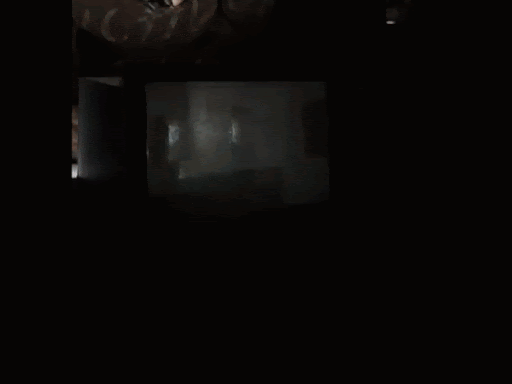
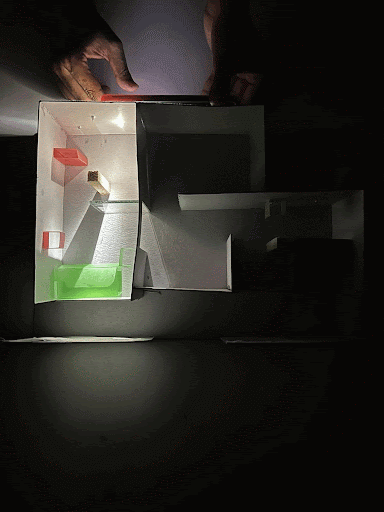
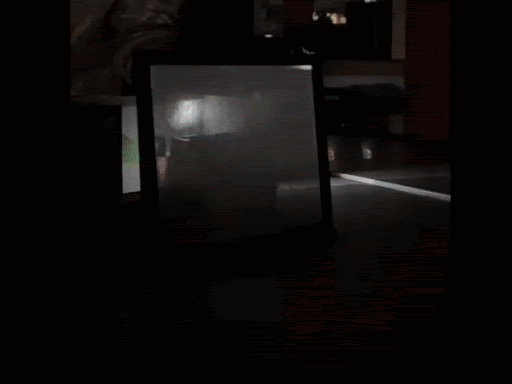
Prajwal Deshmukh

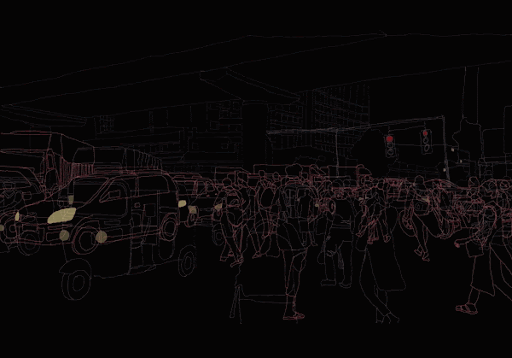
The junction holds many of these rhythms together. By observing and analyzing these rhythms, one can understand what does this congestion, or traffic, in a city hold. It looks at the possibilities that can get generated through this congestion. Since most rhythms at the junction happen simultaneously, they affect the lives of the people that are present there. Rhythms of the vehicles sometimes create spaces of pause for the people who are moving. Slow moving traffic might allow people to stop at the stalls to eat, or have a conversation. While the junction functions at the duration of the signal, the pulsating signal also allows different activities to happen in a short period of time. One may wait for the signal to pause, in order to make a call, to eat, or to just sit and wait.
Having a jester in the city. For example when a mob of people cross the road, a person goes and gives one of the people in the mob an apple. It my or may not strike a conversation.
Prishita Kulkarni
Having a jester in the city. For example when a mob of people cross the road, a person goes and gives one of the people in the mob an apple. It my or may not strike a conversation.
Prishita Kulkarni

^
The rhythm of disposing temple waste. (Cyclical rhythm - every religious festival)
The rhythm of inhabitation of the homeless. (Linear rhythm - everyday routine)
>
The intervention introduces water disposal tanks and floating rafts and lets people engage with the waterbody.
Yash Mhatre
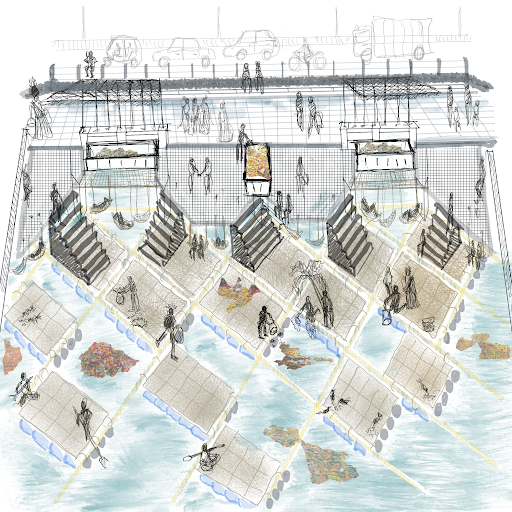


Throughout the day, there is movement of people and vehicles in and out of the station.
Standing on the skywalk, one can observe the different movements, pauses, actions of the different actors on the road below. People rushing early in the morning from share rickshaws - moving towards the entry of the metro or entering the industrial estates. Simultaneously, the crowd from the B.E.S.T bus dispersed in a similar manner. In contrast, the trucks and cars are still, along the edge of the service road since last night- waiting for their drivers. The different movements are in rhythm with one another. The metro comes and goes every 10 minutes- the crowd disperses and gets created again according the timings- people waiting- rickshaws slowing down at the exits but not stopping- fast movement of vehicles on the highway- traffic on the highway (creating a rhythm in itself)- all together make the area polyrhythmic.
The rhythms on site create an energy of slowness and stillness. In a fast moving city, such spaces of waiting during commutes allows the people to slow down as well. The waiting periods become escapes for many employees of the industries, for the people traveling long distances - since the waiting is for a brief period, it allows people to breathe and relax. The intervention should be able to hold and afford the stillness of the place. The space below the escalator and the staircase can become the space which allows it. A form that bends, folds and flows under the constant rhythm of the escalator - allowing the body to sit, stretch, bend as it needs for that brief period of time.
Shreya Mittal

Drawing of forces

Before Intervention

After Intervention
The service duct as an art gallery space is a deliberate attempt to create discomfort to the people irrespective of their identity-residents and housekeeping staff alike. The body is compelled to inhabit a prolonged enclosure with moist and filthy surface in the lobby (before accessing the circulation core) to create an experience of being trapped and consumed by dirt as in the manholes and drainages of the city. The window overlooks the duct area installed with multiple pipe-like structures very close to each other making it evident that the space is intended to be extremely difficult for anyone to inhabit.
The engagement is a satire directed to the casteist society we live in- the city uses them more than they use the city. These are outcomes of close knit consolidations of those who embody privilege and in turn impose severe constraints on the social lives of the ‘others’.
Aakanksha Shah
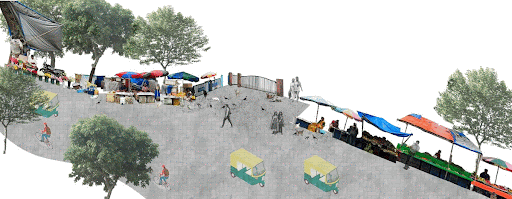
Forces:
- Cats
- Cawing of the crows
- Sound of the rain
- Water from the rain
- Water from the fish vendors
- Smell of the fish, water, rain
- Periodic buses, autos & other vehicles
- Pedestrian movement

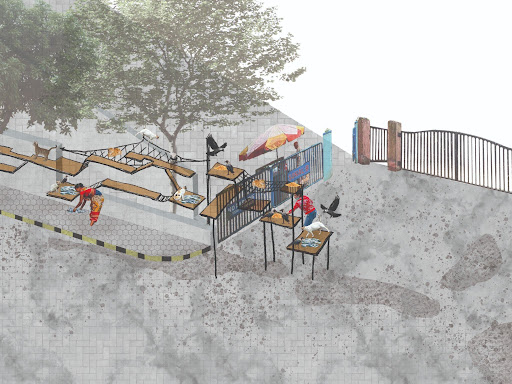

Engagement happens through acts of playing, petting and feeding - series of platforms create a playful landscape where the remains from vendors and the food from the residents can be put.
The corner built of the edges of the compound walls is redesigned to accommodate a playspace for the denizens of the nook. The space also creates places for the residents and fish vendors to place food for the animals and birds.
Rachit Raj Somani


The site as an accumulation, spillage and collection of everyday remains of production. The spillage being central character to the space.
The response emerges as an invitation join the site in its flows. Bricolage becomes a method to incorporate existing elements of the space that over-spill into temporary street objects that attract the folks.
Tanuja Vartak